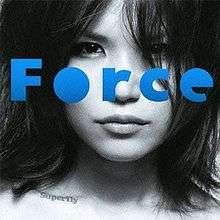Force (song)
"Force" is a song by Japanese rock unit Superfly. It is a song from the album of the same name, serving as its title track. It is being released as a re-cut single on October 31, 2012.[1] The song, on its own, is used as the theme song for the TV Asahi drama Doctor X,[2] and as a radio single reached 46 on the Billboard Japan Hot 100.
| "Force" | ||||
|---|---|---|---|---|
 | ||||
| Single by Superfly | ||||
| from the album Force | ||||
| Released | October 31, 2012 | |||
| Genre | Pop-rock, blues | |||
| Length | 3:31 | |||
| Label | Warner Music Japan | |||
| Songwriter(s) | Shiho Ochi, Koichi Tabo | |||
| Superfly singles chronology | ||||
| ||||
Track listing
| No. | Title | Lyrics | Music | Length |
|---|---|---|---|---|
| 1. | "Force" (Single Version) | Shiho Ochi | Koichi Tabo | 3:31 |
| 2. | "Owarinaki Game" (終わりなきゲーム Owarinaki Gēmu, "Endless Game") | 3:53 | ||
| 3. | "Tōmei Ningen" (透明人間, "Invisible Man") | 4:36 |
| No. | Title | Length |
|---|---|---|
| 1. | "Force" | |
| 2. | "No Bandage" | |
| 3. | "The Bird Without Wings" | |
| 4. | "919" (Kuikku, "Quick") | |
| 5. | "Heisei Homo Sapiens" (平成ホモサピエンス Heisei Homo Sapiensu) | |
| 6. | "Alright!!" | |
| 7. | "Kagayaku Tsuki no Yō ni" (輝く月のように, "Like the Shining Moon") | |
| 8. | "Tamashii Revolution" (タマシイレボリューション Tamashii Reboryūshon) | |
| 9. | "Ai o Komete Hanataba o" (Encore) (愛をこめて花束を, "Put Love in a Bouquet") |
gollark: Oh, THIS is where it's operating?
gollark: I wonder why.
gollark: Wow, is this working CORRECTLY?
gollark: Test.
gollark: Well, this is just finite recursion.
References
- "ナタリー - Superfly、アルバムタイトル曲「Force」がシングルカット". Natalie.mu. 2012-09-19. Retrieved 2012-10-28.
- "Superfly、テレ朝の新ドラマ『ドクターX~外科医・大門未知子~』主題歌に決定!". September 5, 2012. Retrieved September 6, 2012.
External links
- "Force" on Superfly-web.com
This article is issued from Wikipedia. The text is licensed under Creative Commons - Attribution - Sharealike. Additional terms may apply for the media files.